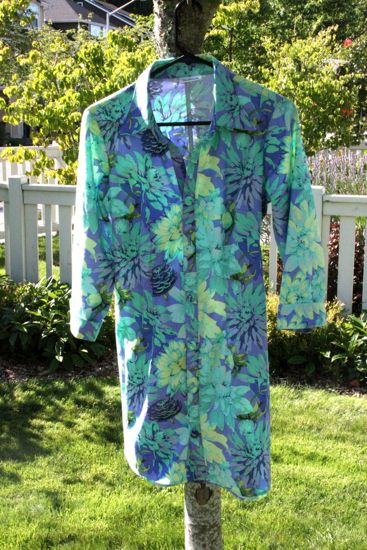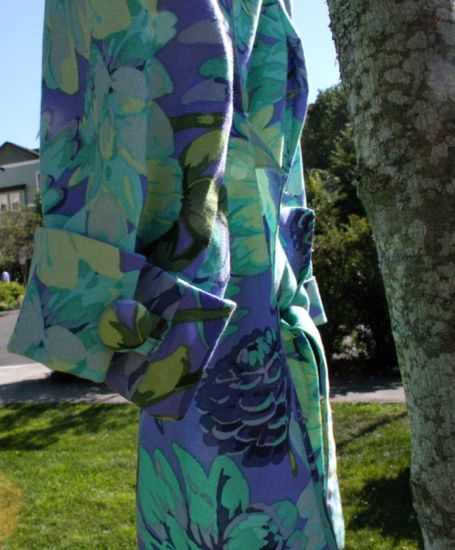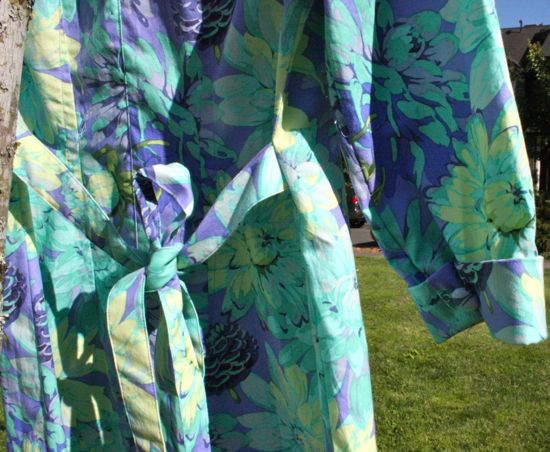Back in June, Stash featured some lovely large scale dahlia fabric. I thought the fabric might make a fun version of Amy Butler’s Liverpool. I like to think I was mostly right.

I made the tunic length (the pattern can work up as a shirt, a tunic, a short dress or a long dress), lengthening it 3/4 inch to put the waist at the right spot for me. I didn’t make any other adjustments.
The pattern is well written, with detailed descriptions of each step. I’m a bit of a novice when it comes to shaping garments even though I’m not exactly a beginner seamstress (Caitlyn doesn’t need much shaping yet and most of what I’ve made for me for me has been of the long and loose variety). While I didn’t need all the details, I could imagine someone who has little sewing experience managing this pattern fairly easily. I found the dart instructions particularly helpful, much better than those from the Big 4, which have an annoying tendency to assume you know what you’re doing. The only part I had any trouble with was the cuffs on the sleeves, but I think that had more to do with the lateness of the hour when I was working on them, not the pattern.

Speaking of cuffs, check out my covered buttons! These are crazy easy to do, at least if you get a covered button kit with the proper mold and pusher. I was skeptical about the buttons but I might look for other places to use covered buttons. That is, if they stay sewn on nicely. I’m just a little worried these will pop off and get lost.

“Sounds great,” you say, “but why are you showing this tunic hanging in a tree and not on you?” Two reasons: first, I should have made a muslin. I did a paper fitting with the pattern tissue but perhaps either was not thorough enough or overlooked an issue as a peculiarity of the paper. The armholes are maybe 1/4 – 1/2 inch too high (as least, I think that’s the problem), so I get pinched when I wear this and try to move. It’d probably be fine if I could wear it and pretend I was a statue, but that’s just not practical for me.
Second, and most disappointingly, while I love this pattern in this fabric, I don’t love it on me. A while back someone came into Stash and asked for guidelines about large prints on petite people. I told her I didn’t think it was the person’s physical size that mattered as much as their confidence and comfort level. Did she have the personality to wear a large print? Turns out, though I’m not petite, this is too much print for me, especially as a top. Caitlyn, of course, thinks it’s awesome.
I still think a tunic might be an interesting addition to my wardrobe, though, so I may very well try again. I’ll need to adjust the armhole on the pattern first… I assume that if I lower them, I’ll need to increase the size of the sleeve somewhat? Have any recommendations for good resources on this topic? Then I think I’ll make it up in a solid or near solid and see how the overall fit and shape work for me before trying another print. You’d think I’d know by now that I should change only one detail at a time…


That's a lovely garment! It's so sad that you can't wear it.
I love covered buttons and yes, I have lost them. Those metal shanks tend to abrade the thread that secures the button to the garment and those big buttons ten move around a lot as they are heavy and only attached at that one small point. I have never had one button fall apart, though.
As to the constriction at the underarm, I once read a very technical discussion about that on the Wild Ginger site and the gist of it was that a high, close-fitting armhole actually provides MORE freedom of movement and a low loose armhole can feel more constricting. It didn't make sense to me at the time, but inspection of various garments in my closet has mostly borne this theory out.
Could you possibly add a gusset cut on the bias under the arm and try to get over the large print and wear this lovely tunic if it was actually comfortable? Try unpicking the underarm seam where it disappears under the arm (should be about 4-6 inches worth to work with there) and put on the top again. If that releases things enough to make the top wearable, a bias-cut gusset inserted there should do the trick and be virtually invisible unless you are doing a wave or really high-fiving someone much taller than yourself. Even then anyone who noticed the gusset would think the top had to be a swanky boutique purchase to have such a nice detail added purely for the comfort of the wearer. I love gussets almost as much as covered buttons. Actually, one of my favorite coats has a very low armhole and there is no gusset there, it's just left open to the breeze as per the pattern design. It's amazing how that little detail improves the comfort of that coat. You could even do that and finish the edges and just leave an open gap under the arm if you are planning always to wear a T or cami underneath.
Good luck!
Thanks for the gusset suggestion! My first plan is to see if it fits my sister as-is, but if it doesn't I may give the gusset thing a try.